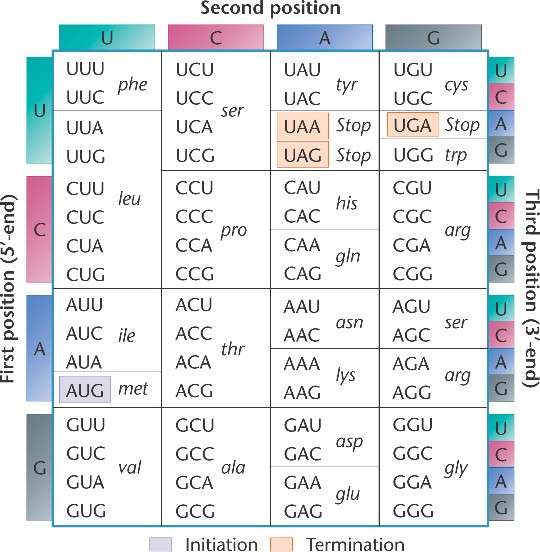- Both the codons UUU and UUC specify the amino acid phenylalanine. What is the term for this phenomenon?
- Which of the following experiments or discoveries did not help to identify the "triplet nature" of the DNA code?
- How many different codons code for an amino acid?
- The wobble hypothesis involves
- In prokaryotes, the initial amino acid in a polypeptide chain is the modified form of methionine, N-formylmethionine, or f-met. Which term describes the codon for f-met?
- RNA synthesis from a DNA template is called
- Which subunit of RNA polymerase establishes template binding to a promoter in prokaryotes?
- Where does transcription in prokaryotes end?
- A gene's stop codon
- A gene's stop anticodon
- A region beyond the end of one or more tandem genes
- A region called the TATA box
- A region at the head of every gene
- prokaryotes may contain polycistronic mRNA
- Which RNA polymerase transcribes protein-coding genes into mRNA in eukaryotes?
- Which of the following statements about the effects of enhancers and transcription factors (TFs) on gene expression is true?
- What are the two main types of posttranscriptional modifications that take place in the mRNA of eukaryotes?
- The addition of a poly-T sequence at the 5' end of the gene and the addition of a poly-U tail at the 3' end.
- The addition of a 7-mG cap at the 5' end of the transcript and the addition of a poly-A sequence at the 3' end of the message.
- The addition of a poly-A sequence at the 5' end and the addition of a 7-mG cap at the 3' end of the RNA transcript.
- The excision of the introns and the addition of a 7-mG cap to the 3' end.
- Which of the following does not involve introns?
- Which mRNA sequence is transcribed from the DNA template strand TACGGGATT?
-
 Which amino acids would be incorporated in a repeating copolymer assay involving A and U?
Which amino acids would be incorporated in a repeating copolymer assay involving A and U?
- Isoleucine (ile) would be incorporated into the protein.
- Phenylalanine (phe) would be incorporated into the protein.
- Isoleucine and tyrosine would both be incorporated into the protein.
- Leucine (leu) would be incorporated into the protein.
- No amino acids are incorporated, since only stop codons are present.
- The codons UGU and UGC both code for cysteine. The anticodon for UGU is ACA. What is the anticodon for UGC?
- What is the consequence of a mutational event that inserts the codon UGA into a gene?
- Which term describes sequences that are similar (homologous) in different genes of the same organism or in one or more genes of related organisms?
- What is the function of transcription factors?
- Which of the following events does not happen during hnRNA processing?
- A DNA sequence produces a mutant protein in which several amino acids in the middle of the protein differ from the normal protein. What kind of mutation could have occurred?
- Which of the following statements about eukaryotic transcription is false?
- A polycistronic mRNA may be transcribed if the gene products are used in the same pathway or needed at the same time.
- The transcripts produced contain both exons and introns.
- Eukaryotic promoter regions contain a TATA box and a CAAT box.
- Transcription initiation occurs when RNA polymerase blinds to a complex of transcription factors at the TATA box.